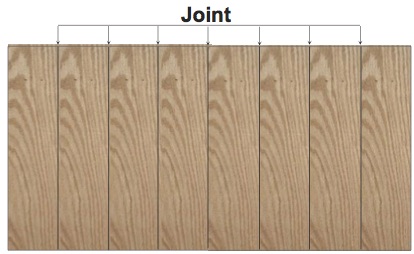Veneer Assembly
Assembly of Veneer Flitches on Faces
The assembly refers to how the specified matched veneer flitches as outlined on the “Veneer Matching” page are to be assembled across the given panel or door width. Some of the particular matches across the a given door width will determine flitch sizes and associated costs due to the yield that some require from the log. It must also be noted that there is a nominal minimum flitch width for both premium (“AA”) and custom (“A”) grade product and it does vary between the different veneer cuts.
If no match is specified than by default “Running Match” will be utilized as this is the most common type for “A” grade doors. If sequence or blue print matching are required it must be specified as some suppliers may only match up to a certain amount of panels due to the yield from the log.
Shown below are the three basic matches that are specified for architectural doors.
RUNNING MATCH
This match is the standard or default if no other match is specified for custom (“A”) grade faces. This is also the most economical of all the matches as it can be produced from larger flitches of un-equal width. In most cases the outer edges of the final trimmed panel or face will be narrower than the inner flitches. It is strongly recommended that this match not be specified when sequential matching from door to door is required.

BALANCE MATCH
Each face is assembled from flitches of equal width. It may contain an equal or odd number of flitches within the trimmed panel or face. An odd number of flitches will result in the outer flitch from one edge to the next to be oriented in a different direction on book matched faces.
Only at the outer edges will the flitch width differ by up to a maximum of one inch as allowed by standards.

CENTER BALANCE MATCH
This match requires that there be an equal number of flitches of equal width. This places a joint in the middle of the trimmed panel. The outer panels may be reduced after trim up to 1” on custom (“A”) grade and 1/2” of premium (“AA”) grade panels. The exact allowance on the offset of the center joint is 1/4” to 3/8”. The yield factor for this particular match is somewhat higher and therefore the cost is augmented particularly on some species if available.

SLIP CENTER BALANCE MATCH
Quarter and rift (comb) cuts are generally specified for this type of match. The panel is comprised of equal sized flitches with a center joint where the two center flitches are book matched and the direction is mirrored from the opposite side for the balance of the panel. All other aspects apply to “center balance” match.

Pair, Set and End Matching
STANDARD And DOUBLE EGRESS PAIRS
Both leaves are of
equal width or 1/2 of
the nominal opening.

UN-EQUAL PAIRS
The active leaf is larger than the in- active leaf.

SET MATCHES

END MATCH
The doors and panels are made with the same matching faces and the panel is rotated 180 degrees to match the top of the door with the patterns mirrored. This is typically used for custom but can be used at premium grade as well.
Note: A slight misalignment may occur between panels which is allowed. Maxi- mum is 3/8” on singles and 1/2” on pairs.

CONTINUOUS MATCH
The doors and panels are made with the same matching faces, in most cases the assemble face is supplied long enough to account both the length of door and transom. The final result is a continuous grain match from the top to the transom or panel to the bottom of the door. This is typically used for premium grade.
Note: A slight misalignment may occur between panels which is allowed. Maximum is 3/8” on singles and 1/2” on pairs.

Click here to download PDF version.
